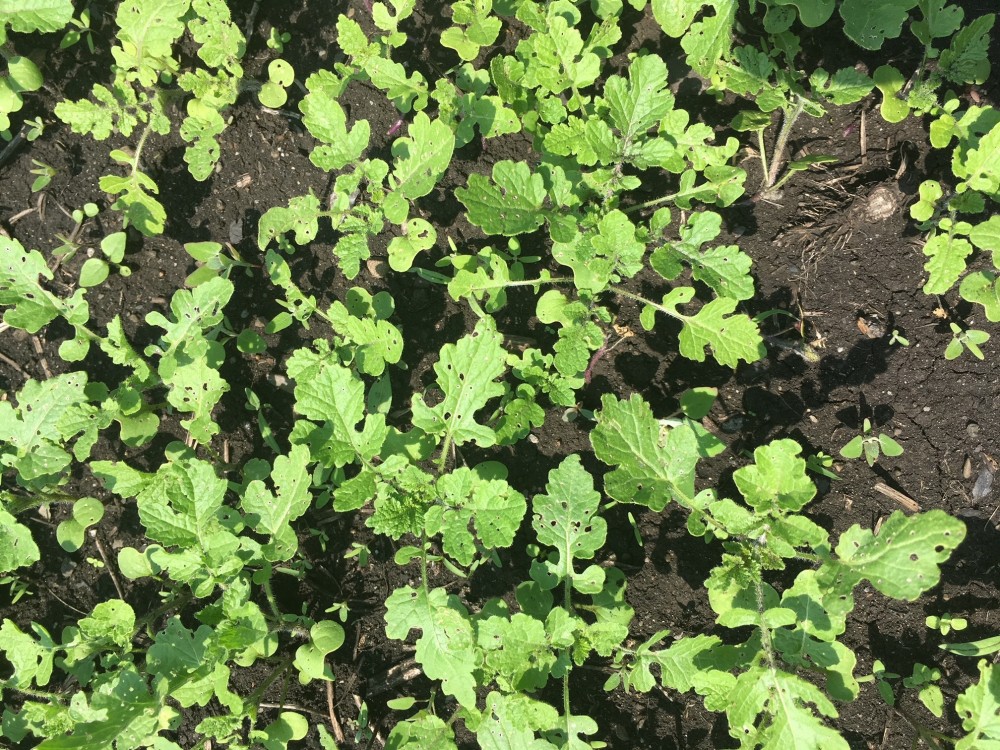OMRI and Conventional Options for Flea Beetle Suppression
Ethan Grundberg, Vegetable Specialist
Eastern New York Commercial Horticulture
Crucifer flea beetles, Phyllotreta cruciferae Goeze, emerged abruptly with some warm weather in mid-May and have been causing damage on susceptible brassica crops. Most growers are all-too-familiar with this pest and have a few strategies to limit damage from flea beetles already in their toolbox. However, this generation of flea beetles will continue to be active through around mid-June, so it's worth revisiting a few of the other options available if your preferred method falls short this season.
Prevention: Young transplants and recently emerged direct seeded crops at the cotyledon stage are the most susceptible to damage. Rotating spring brassicas as far away from fields that had cole crops the previous fall can help reduce the pressure. Keeping field edges clean of mustard weeds can also reduce flea beetle populations that then migrate into production areas. On a smaller scale, insect netting or floating row cover can also be used, but must be secured at soil level before flea beetle emergence to prevent them from getting underneath and having a feast. Mustard cover crops, as shown in the image, can also be flea beetle magnets and should be carefully managed as far away from brassica cash crop fields as possible. Once flea beetles have reached a threshold of an average of 1 beetle per plant or 10% average leaf damage, it's time to consider chemical control options.
Conventional Options: There are a number of pyrethroid (IRAC Group 3A) insecticides labeled for flea beetles that provide quick knock downs of populations. A few of the labeled pyrethroids labeled for use in New York are Baythroid XL (beta-cyfluthrin), Brigade 2EC (bifenthrin), Warrior II with Zeon Technology (lambda-cyhalothrin), and Mustang MAXX (zeta-cypermethrin). Given that this generation of flea beetles will still be active for a few weeks, growers may want to consider pre-mix products of pyrethroids and neo-nicotinoids (IRAC Group 4A) that will provide longer residual control. Two common options are Leverage 2.7 (imidacloprid + cyfluthrir) and Endigo ZC (lambda-cyhalothrin + thiamethoxam). One other pre-mix product with longer residual than a straight pyrethroid and with less potential to hurt pollinators than the neo-nic mixes is Voliam Xpress. Voliam Xpress is a mix of lambda-cyhoalothrin and the IRAC Group 28 diamide insecticide chlorantraniliprole (same active ingredient in Exirel). The neo-nicotinoid Admire Pro (imidacloprid) is labeled as a foliar spray for flea beetles. Please note, soil applications of Admire Pro on brassicas are only labeled for aphid, leafhopper, thrip, and white fly control, NOT for flea beetles. In a 2015 field trial conducted in Virginia, Brigade provided the best level of flea beetle suppression when compared to Admire Pro and Exirel.
Organic Options: Like with the conventional options, there are a number of OMRI options labeled for flea beetle suppression. However, in field trials both at UMass and New York State IPM, few provided a statistically significant reduction in flea beetle pressure over untreated controls. Spinosad products, like Entrust, have generally shown the highest efficacy and can be mixed with OMRI-approved spreader-stickers to improve performance. A trial in Maryland from 2011 showed good performance from Azera, a pre-mix of azadirachtin and pyrethrins (IRAC Group 3A), especially when mixed with Surround WP (kaolin clay). Finally, a 2013 trial in New York found that both Grandevo (Chromobacterium subtsugae strain PRAA4-1T and spent fermentation media) and Venerate (Heat-killed Burkholderia spp. strain A396 cells and spent fermentation media) reduced flea beetle damage on cabbage under low pressure.
This article was printed in the May 24th, 2018 issue of ENYCHP Veg News. To view the full newsletter, click here.
 Typcial shotgun type small holes caused by crucifer flea beetle
Typcial shotgun type small holes caused by crucifer flea beetlefeeding on white mustard cover crop

Upcoming Events
2026 Winter Cut Flower Webinar Series
January 6, 2026
The fifth annual CCE Cut Flower Webinar Series begins on January 6, 2026 and continues over 5 weeks on Tuesdays. This is a very popular series of online events you won't want to miss, with topflight speakers, a wide variety of subjects concerning growing cut flowers and plenty of interaction between speakers and attendees.
Tuesdays 1pm-3pm January 6, 2026 - February 3, 2026 (The webinar held on February 3 will run 1pm-4pm)
Cost: $60.00 for all five sessions, $20 for single sessions
Webinars will be recorded, and all the recordings will be sent to registrants for future review.
Expanding Farm Sales: Markets, Profits, and Branding Series
January 10, 2026
Looking to diversify where you sell your farm products? This four-part workshop series helps farmers explore new opportunities in direct-to-consumer, wholesale, and institutional markets. Learn how to meet buyer expectations, price for profitability, and build lasting relationships that support your business goals. Participants will strengthen marketing and communication skills, evaluate which sales channels best fit their farm, and connect with buyers, distributors, and local partners who can help expand their reach. Whether you're just starting out or ready to grow your market presence, this program will help you chart the right path for your farm's future.
Four Session Series: Saturdays from 10AM to Noon, January 10-January 31, 2026
Attend at one of three locations: Schoharie Extension Center - Cobleskill, NY; Otsego Education Center - Cooperstown, NY; Via Zoom
Pre-registration is requested! Fee: $25 Register Here
Any questions can be directed to Kelley Doolin at kmd322@cornell.edu
Pesticide Applicator Certification Exam Prep Course
January 13 - January 14, 2026
Join ENYCHP specialists for an in-depth review of topics covered on the NYS DEC pesticide applicator certification exam. This two-day virtual course includes explanation of key concepts on the core exam, test-taking tips for the core and category exam, practice questions, and Q&A with instructors. Course materials, including program recordings, practice exams, and DEC materials will be available to registrants after the program. This training is geared toward certification categories 1A (agricultural plant), 21 (field and forage), 22 (fruit), and 23 (vegetable).












































